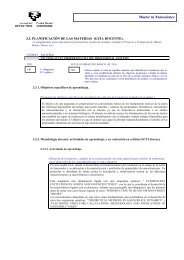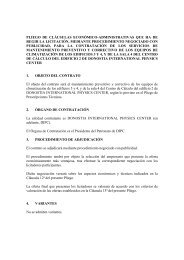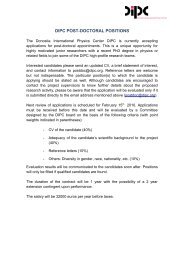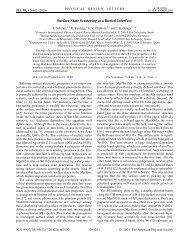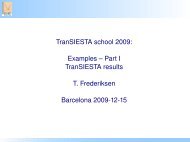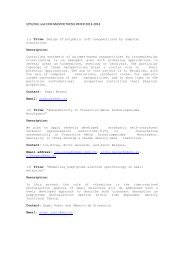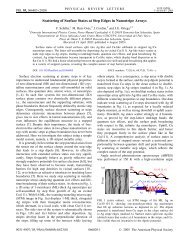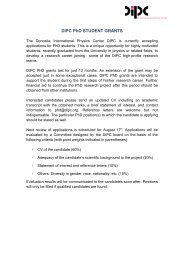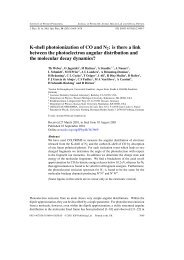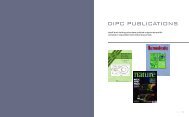Flocculation in Carbon Black Filled Rubber ... - All-electronics.de
Flocculation in Carbon Black Filled Rubber ... - All-electronics.de
Flocculation in Carbon Black Filled Rubber ... - All-electronics.de
You also want an ePaper? Increase the reach of your titles
YUMPU automatically turns print PDFs into web optimized ePapers that Google loves.
ROHSTOFFE UND ANWENDUNGEN<br />
RAW MATERIALS AND APPLICATIONS<br />
<strong>Carbon</strong> <strong>Black</strong> <strong>Flocculation</strong> Microdispersion<br />
Bound <strong>Rubber</strong><br />
The properties of carbon black filled<br />
rubber compounds are greatly <strong>in</strong>fluenced<br />
by the extent of filler microdispersion.<br />
Dispersion takes place<br />
dur<strong>in</strong>g mix<strong>in</strong>g where carbon black<br />
pellets are broken up un<strong>de</strong>r shear<br />
forces <strong>in</strong>to <strong>in</strong>dividual aggregates/<br />
agglomerates and distributed<br />
throughout the polymer matrix.<br />
After the mix<strong>in</strong>g process, both the<br />
polymer and filler matrices can rearrange,<br />
lead<strong>in</strong>g to the reaglomeration<br />
of the filler network. This process<br />
is called flocculation. In this<br />
paper, flocculation is evaluated by<br />
the variation of the electrical resistivity<br />
of rubber samples aged un<strong>de</strong>r<br />
different conditions. A broad range<br />
of carbon black filled compounds<br />
were analyzed. Additionally, the correlation<br />
between flocculation and<br />
bound rubber was studied.<br />
Flokkulation <strong>in</strong> ruûgefuÈllten<br />
Kautschukmischungen<br />
Ruû Flokkulation Ruûdispersion <br />
Mikrodispersion Bound-<strong>Rubber</strong><br />
Die Eigenschaften von ruûgefuÈ llten<br />
Mischungen s<strong>in</strong>d stark von <strong>de</strong>r Mikrodispersion<br />
bee<strong>in</strong>fluût. Die Dispersion<br />
erfolgt waÈ hrend <strong>de</strong>s Mischens,<br />
wenn Pellets unter Scherung<br />
<strong>in</strong> e<strong>in</strong>zelne Aggregate/Agglomerate<br />
abgebaut und <strong>in</strong> <strong>de</strong>r Polymermatrix<br />
verteilt wer<strong>de</strong>n. Nach<br />
<strong>de</strong>m Mischprozess kann die Polymer-FuÈ<br />
llstoffmatrix sich umorganisieren,<br />
wodurch e<strong>in</strong>e Reagglomeration<br />
<strong>de</strong>s FuÈ llstoffnetzwerks stattf<strong>in</strong><strong>de</strong>t.<br />
Dieser, auch als Flokkulation<br />
bekannter Prozess, wird <strong>in</strong> diesem<br />
Beitrag uÈ ber die Variation <strong>de</strong>r elektrischen<br />
LeitfaÈ higkeit von <strong>in</strong> verschie<strong>de</strong>nen<br />
Bed<strong>in</strong>gungen gelagerten<br />
Proben untersucht. Zu<strong>de</strong>m wird<br />
auch e<strong>in</strong>e Korrelation zwischen<br />
Flokkulation und Bound-<strong>Rubber</strong><br />
durchgefuÈ hrt.<br />
<strong>Flocculation</strong> <strong>in</strong> <strong>Carbon</strong> <strong>Black</strong><br />
<strong>Filled</strong> <strong>Rubber</strong> Compounds 1<br />
M. Gerspacher, L. Nikiel, H. H. Yang,<br />
and C. P. O'Farrell, Fort Worth, (USA)<br />
G. A. Schwartz, Buenos Aires (Argent<strong>in</strong>a)<br />
Properties and performance of rubber<br />
compounds are <strong>de</strong>pen<strong>de</strong>nt on the filler<br />
microdispersion. In general, better filler<br />
microdispersion leads to better rubber<br />
compound performance. This is true regardless<br />
of the type of filler used. However,<br />
<strong>in</strong> this paper only carbon black filled<br />
rubber compounds are consi<strong>de</strong>red.<br />
The dispersion process generally takes<br />
place dur<strong>in</strong>g shear mix<strong>in</strong>g and it is prece<strong>de</strong>d<br />
by carbon black <strong>in</strong>corporation<br />
<strong>in</strong>to the polymeric matrices. After shear<br />
mix<strong>in</strong>g, the rubber compound rema<strong>in</strong>s,<br />
from a thermodynamical po<strong>in</strong>t of view,<br />
<strong>in</strong> an unstable state. The polymer cha<strong>in</strong>s<br />
tend to rearrange themselves lead<strong>in</strong>g to a<br />
new configuration of the <strong>in</strong>terpenetrated<br />
filler and polymer networks. Dur<strong>in</strong>g this<br />
rearrangement the <strong>in</strong>terpenetrated carbon<br />
black/polymer networks <strong>de</strong>nsifies,<br />
result<strong>in</strong>g <strong>in</strong> changes <strong>in</strong> electrical and mechanical<br />
properties of the compound.<br />
This phenomena is referred to as flocculation.<br />
This process is thermodynamically<br />
driven and is strongly <strong>de</strong>pen<strong>de</strong>nt on temperature<br />
and as such can be greatly accelerated<br />
by thermal ag<strong>in</strong>g of the rubber.<br />
S<strong>in</strong>ce flocculation leads to <strong>in</strong>terpenetrated<br />
carbon black/polymer networks<br />
<strong>de</strong>nsification, the experimental methods<br />
to study this phenomena should be sensitive<br />
to <strong>de</strong>tect these changes. Low stra<strong>in</strong><br />
dynamic measurements are capable of<br />
prob<strong>in</strong>g carbon black network <strong>de</strong>nsity,<br />
however dur<strong>in</strong>g dynamic measurements,<br />
the sample is subjected to external stra<strong>in</strong><br />
and the filler network is <strong>de</strong>formed, greatly<br />
reduc<strong>in</strong>g the sensitivity and therefore limit<strong>in</strong>g<br />
the applicability of this method. On<br />
the other hand, electrical measurements<br />
seem to be an i<strong>de</strong>al choice to study this<br />
flocculation phenomena. The resistivity of<br />
a rubber compound <strong>de</strong>pends largely on<br />
1 Presented at a meet<strong>in</strong>g of the <strong>Rubber</strong> Division,<br />
American Chemical Society, Cleveland, Ohio,<br />
the local fluctuation of <strong>de</strong>nsity of the <strong>in</strong>terpenetrated<br />
carbon black/polymer networks.<br />
Overall, the resistivity of rubber<br />
compounds is a complicated phenomena<br />
<strong>de</strong>pend<strong>in</strong>g on a large number of<br />
parameters (i.e. carbon black type, carbon<br />
black micro-dispersion, polymer<br />
type, temperature and others).<br />
The changes <strong>in</strong> electrical resistivity with<br />
thermal ag<strong>in</strong>g, as well as the changes of<br />
mechanical dynamic properties, have<br />
been reported previously [1-6]. However,<br />
the reports <strong>in</strong> scientific and tra<strong>de</strong> literature<br />
<strong>de</strong>al<strong>in</strong>g with flocculation are limited and<br />
no s<strong>in</strong>gle source addressed the issue<br />
with sufficient <strong>de</strong>pth to fully un<strong>de</strong>rstand<br />
the mechanism of flocculation. The usual<br />
approach to this problem assumes that<br />
after the mix<strong>in</strong>g process the filler aggregates<br />
will slowly reagglomerate (flocculate).<br />
In other words, the aggregates or<br />
agglomerates move randomly by thermal<br />
agitation through the polymer matrix and<br />
have a given probability to stick together<br />
with another carbon black agglomerate.<br />
This <strong>in</strong>creases the <strong>de</strong>nsity of the percolated<br />
conductive filler cluster and therefore<br />
<strong>de</strong>creases the electrical resistivity.<br />
When the aggregates are close enough,<br />
they can be attracted to each other<br />
by Van <strong>de</strong>r Waals forces. Besi<strong>de</strong>s the attractive<br />
potential between aggregates of<br />
the filler, the flocculation process is <strong>de</strong>term<strong>in</strong>ed<br />
by diffusion of the aggregates due<br />
to Brownian motion to form thermodynamically<br />
stable agglomerates. For a given<br />
polymer-filler system, the diffusion of the<br />
filler aggregates <strong>in</strong> the polymer matrix<br />
play an important role <strong>in</strong> the flocculation<br />
k<strong>in</strong>etics. Some authors [6 ± 8] calculate<br />
the diffusion coefficient (d) given by the<br />
E<strong>in</strong>ste<strong>in</strong>-Stokes relation as [9]:<br />
1<br />
d ˆ kT<br />
…1†<br />
6pga<br />
where k is the Boltzman constant, T the<br />
absolute temperature, g the medium<br />
596 KGK Kautschuk Gummi Kunststoffe 55. Jahrgang, Nr. 11/2002
<strong>Flocculation</strong> <strong>in</strong> <strong>Carbon</strong> <strong>Black</strong> <strong>Filled</strong> <strong>Rubber</strong> Compounds<br />
about 38 mm <strong>in</strong> diameter were obta<strong>in</strong>ed.<br />
Top and bottom faces of the samples<br />
were gold sputtered to ensure good electrical<br />
contact with the electro<strong>de</strong>s and<br />
elim<strong>in</strong>ate the contact resistance. The<br />
samples were prepared us<strong>in</strong>g a wi<strong>de</strong><br />
range of elastomers rang<strong>in</strong>g from solution<br />
SBRs to Natural <strong>Rubber</strong>.<br />
Fig. 1 shows the equipment built by the<br />
authors that allows conduct<strong>in</strong>g the measurements<br />
at constant temperature.<br />
The samples were placed between chromium<br />
plated copper electro<strong>de</strong>s that are <strong>in</strong><br />
thermal contact with two heaters. The<br />
middle sample fitted with a thermocouple<br />
was used to control the temperature<br />
us<strong>in</strong>g an Omega temperature controller.<br />
The resistivity was measured us<strong>in</strong>g a<br />
Keithley Electrometer 6517A equipped<br />
with a Keithley 6522 multiplexer card<br />
that allows measurement of up to ten<br />
samples at a time. The electrometer<br />
was controlled by a personal computer<br />
through an RS232 port. More <strong>de</strong>tailed<br />
<strong>de</strong>scription of the equipment and the experimental<br />
technique can be found elsewhere<br />
[10]. The samples were placed between<br />
electro<strong>de</strong>s at room temperature<br />
and the <strong>in</strong>itial volume resistivity measurements<br />
were ma<strong>de</strong>. This first measurement<br />
is the reference po<strong>in</strong>t to calculate<br />
the extent of the resistivity change.<br />
Next, the temperature was <strong>in</strong>creased to<br />
60 8C, 80 8C, and 100 8C respectively.<br />
After the temperature reaches the set<br />
mark (at a rate of 1 8C/m<strong>in</strong>), the volume<br />
resistivity data were collected for<br />
24 hours. F<strong>in</strong>ally, the samples were<br />
cooled to room temperature (<strong>in</strong> about<br />
30 m<strong>in</strong>utes) and after another 24 hours,<br />
the f<strong>in</strong>al volume resistivity data were collected.<br />
These measurements allow calculat<strong>in</strong>g<br />
the rate of the resistivity <strong>de</strong>crease<br />
from the slope of the regression l<strong>in</strong>e fitted<br />
to the volume resistivity data vs. time. The<br />
flocculation <strong>in</strong>tensity is calculated as the<br />
or<strong>de</strong>rs of magnitu<strong>de</strong> change <strong>in</strong> the volume<br />
resistivity value between the correspond<strong>in</strong>g<br />
room temperature measurements.<br />
The <strong>de</strong>tails of temperature sequences<br />
and performed measurements<br />
are expla<strong>in</strong>ed <strong>in</strong> Figures 2a and 2b.<br />
viscosity and a the particle diameter.<br />
From this equation it can be <strong>de</strong>duced<br />
that at constant temperature, the flocculation<br />
rate is controlled by the polymer<br />
viscosity and the overall size of the aggregates<br />
(radius of gyration, R g ).<br />
Recently, Bohm and Nguyen [7] have<br />
studied the flocculation of carbon black<br />
<strong>in</strong> rubber compounds, us<strong>in</strong>g the Payne<br />
effect as evi<strong>de</strong>nce of flocculation. Also,<br />
Jager and MacQueen, [8] have used<br />
electrical measurements to analyze the<br />
k<strong>in</strong>etics of the flocculation process.<br />
They measured the electrical resistivity<br />
of EBA (ethylene butylacrylate copolymer)<br />
filled with carbon black at different load<strong>in</strong>gs<br />
and ag<strong>in</strong>g temperatures. In this paper,<br />
flocculation of the carbon black filler<br />
<strong>in</strong> uncured rubber compounds will be <strong>in</strong>vestigated.<br />
<strong>Flocculation</strong> occurs to a<br />
much larger extent <strong>in</strong> uncured compounds<br />
however this process can also<br />
be observed <strong>in</strong> cured rubber. An important<br />
dist<strong>in</strong>ction between uncured rubber<br />
compounds with and without the <strong>in</strong>corporation<br />
of curatives will be <strong>de</strong>monstrated.<br />
It was found dur<strong>in</strong>g the course<br />
of this study that a correlation between<br />
bound rubber and flocculation exist. An<br />
explanation of these phenomena will be<br />
proposed.<br />
Experimental<br />
Test Procedure ±<br />
Electrical Measurements<br />
<strong>All</strong> rubber compounds used <strong>in</strong> this study<br />
were mixed us<strong>in</strong>g a Haake Rheocord 90<br />
<strong>in</strong>ternal mixer. After mix<strong>in</strong>g, the compounds<br />
were mill sheeted to 12 mm<br />
thickness and cyl<strong>in</strong>drical samples of<br />
Fig. 1. The experimental<br />
setup for<br />
electrical measurements<br />
Test procedure ± Bound rubber<br />
The bound rubber measurement was<br />
conducted at room temperature us<strong>in</strong>g toluene<br />
as the extract<strong>in</strong>g solvent. Approximately<br />
1 gram of rubber compound was<br />
cut <strong>in</strong>to small pieces and placed <strong>in</strong>to a<br />
sta<strong>in</strong>less-steel wire-mesh cage of known<br />
weight. The cage was then immersed <strong>in</strong><br />
solvent for four days. The toluene was replaced<br />
every day with fresh solvent. After<br />
extraction, the rubber and the cage were<br />
dried <strong>in</strong> a hood for one hour and then <strong>in</strong><br />
an oven at 125 8C for another 5 hours.<br />
Percentage of the bound rubber was calculated<br />
accord<strong>in</strong>g to the follow<strong>in</strong>g equation:<br />
Bound <strong>Rubber</strong> …%† ˆ<br />
W B …m f ‡ m p † W A m f<br />
…2†<br />
W A m p<br />
where W B and W A are the mass of the<br />
compound after and before extraction,<br />
m f and m p are the mass of the filler and<br />
the polymer <strong>in</strong> the compound.<br />
Test procedure ± Low stra<strong>in</strong>,<br />
low frequency dynamic properties<br />
The dynamic measurements were performed<br />
on the ARES (Advanced Rheometrics<br />
Expansion System) system us<strong>in</strong>g<br />
the parallel plate geometry [11]. Samples<br />
were cured between alum<strong>in</strong>um plates of<br />
25 mm <strong>in</strong> diameter. Typical sample thickness<br />
was ma<strong>in</strong>ta<strong>in</strong>ed at about 2.5 mm.<br />
The test was performed at a frequency<br />
of 1 Hz and a stra<strong>in</strong> sweep from 0.1 to<br />
10%. An environmental chamber controlled<br />
the temperature at 30 8C.<br />
Test procedure ± High frequency<br />
dynamic properties<br />
The high frequency dynamic data were<br />
collected us<strong>in</strong>g the Sid Richardson <strong>Carbon</strong><br />
Co. <strong>de</strong>veloped ultrasonic spectro-<br />
KGK Kautschuk Gummi Kunststoffe 55. Jahrgang, Nr. 11/2002 597
<strong>Flocculation</strong> <strong>in</strong> <strong>Carbon</strong> <strong>Black</strong> <strong>Filled</strong> <strong>Rubber</strong> Compounds<br />
Fig. 2 a. The resistance of the rubber compound monitored as a<br />
function of time and ag<strong>in</strong>g temperature<br />
Fig. 2 b. The volume resistivity monitored as a function of time at<br />
constant ag<strong>in</strong>g temperature<br />
meter operat<strong>in</strong>g at frequency 1 MHz [12±<br />
14]. The <strong>in</strong>strument is capable of perform<strong>in</strong>g<br />
an automatic temperature sweep<br />
<strong>in</strong> the range of 90 8C to ‡ 60 8C. In this<br />
measurement, only room temperature<br />
data were collected. The <strong>de</strong>tails of this<br />
method were <strong>de</strong>scribed previously [14].<br />
A higher attenuation coefficient value <strong>in</strong>dicates<br />
more immobilization of polymer<br />
cha<strong>in</strong>s due to <strong>in</strong>creased polymer/filler <strong>in</strong>teraction<br />
<strong>in</strong> the system after flocculation.<br />
Test procedure ± Transmission electron<br />
microscopy (TEM)<br />
TEM pictures were collected for samples<br />
before and after thermal ag<strong>in</strong>g. In addition,<br />
the <strong>in</strong>-situ ag<strong>in</strong>g, i.e. heat ag<strong>in</strong>g <strong>in</strong><br />
the TEM chamber, was performed. Samples<br />
were prepared us<strong>in</strong>g ultra-cryogenic<br />
microtome and viewed us<strong>in</strong>g Philips 300<br />
TEM [15]. The magnification selected allows<br />
us to clearly observe s<strong>in</strong>gle carbon<br />
black aggregates/agglomerates and<br />
theirs relative positions.<br />
Experimental results<br />
It was observed dur<strong>in</strong>g the course of this<br />
study that flocculation is evi<strong>de</strong>nt <strong>in</strong> the<br />
uncured stage and <strong>in</strong> cured rubber compounds.<br />
<strong>Flocculation</strong> happens also dur<strong>in</strong>g<br />
the cur<strong>in</strong>g process. As a consequence<br />
of these f<strong>in</strong>d<strong>in</strong>g the paper will<br />
be divi<strong>de</strong>d to cover separately the measurements<br />
performed on the uncured and<br />
cured rubber compounds. In addition,<br />
the different experimental techniques applied<br />
will be discussed <strong>in</strong> separate subsections.<br />
Uncured rubber compounds<br />
electrical measurements<br />
<strong>Rubber</strong> compounds prepared with four<br />
different polymers (Natural <strong>Rubber</strong>, Dura<strong>de</strong>ne<br />
711, Dura<strong>de</strong>ne 709, and Sn-SSBR)<br />
and carbon black (N330) load<strong>in</strong>g rang<strong>in</strong>g<br />
from 30 to 60 phr were prepared with no<br />
chemical curatives. The volume resistivity<br />
was monitored for each sample accord<strong>in</strong>g<br />
to the procedure <strong>de</strong>scribed above.<br />
The data <strong>in</strong> Table 1 <strong>in</strong>dicate that there<br />
is a strong <strong>de</strong>pen<strong>de</strong>nce of flocculation <strong>in</strong>tensity<br />
on ag<strong>in</strong>g temperature. For the<br />
samples with the same composition,<br />
higher ag<strong>in</strong>g temperature results <strong>in</strong> larger<br />
flocculation <strong>in</strong>tensity. In addition, as it can<br />
be observed <strong>in</strong> Table 1, the flocculation<br />
<strong>in</strong>tensity <strong>de</strong>pends on carbon black load<strong>in</strong>g<br />
and seems to exhibit a maximum<br />
around the percolation threshold. The<br />
data <strong>in</strong> Table 1 <strong>de</strong>monstrate that the flocculation<br />
<strong>in</strong>tensity is also polymer <strong>de</strong>pen<strong>de</strong>nt.<br />
One of the hypothesis based on<br />
Equation 1, suggests that polymer viscosity<br />
is responsible for these difference.<br />
In Fig. 3, the flocculation <strong>in</strong>tensity was<br />
plotted as a function of polymer Mooney<br />
viscosity for several different carbon black<br />
load<strong>in</strong>gs. As expected, the lower polymer<br />
viscosity leads to the higher flocculation<br />
<strong>in</strong>tensity.<br />
For Natural <strong>Rubber</strong>, a simple way to reduce<br />
the viscosity is to premasticate the<br />
polymer. Data obta<strong>in</strong>ed for premasticated<br />
Natural <strong>Rubber</strong> <strong>in</strong>dicate larger flocculation<br />
<strong>in</strong>tensity as compared to ªvirg<strong>in</strong>º polymer.<br />
The <strong>de</strong>pen<strong>de</strong>nce of flocculation <strong>in</strong>tensity<br />
on polymer viscosity and ag<strong>in</strong>g<br />
temperature confirms the fact that the<br />
flocculation is a diffusion-controlled process<br />
(Equation 1). In or<strong>de</strong>r to further prove<br />
this fact the analysis of the flocculation <strong>in</strong>tensity<br />
versus carbon black size (gra<strong>de</strong>)<br />
was performed. Twelve different gra<strong>de</strong>s<br />
of carbon black were selected and rubber<br />
compounds us<strong>in</strong>g Sn-SSBR were prepared.<br />
Sn-SSRB was used because it exhibits<br />
the highest flocculation <strong>in</strong>tensity. As<br />
was shown above, the changes <strong>in</strong> resistivity<br />
values after and before ag<strong>in</strong>g <strong>in</strong>crease<br />
significantly when load<strong>in</strong>g approaches<br />
the percolation threshold. Below,<br />
but near, percolation there are no<br />
cont<strong>in</strong>uous pathways to carry any electrical<br />
current. However, certa<strong>in</strong> probability<br />
exist that some contacts improve or<br />
new pathways are created <strong>de</strong>creas<strong>in</strong>g<br />
the electrical resistivity. On the other<br />
hand, above, but near, percolation new<br />
conductive pathways can be created dur<strong>in</strong>g<br />
ag<strong>in</strong>g <strong>in</strong> addition to the exist<strong>in</strong>g ones.<br />
In both cases, any small fluctuation of the<br />
polymer-filler arrangement substantially<br />
modifies the electrical resistivity. Far<br />
from percolation, both above and below,<br />
small changes <strong>in</strong> the filler network have <strong>in</strong>significant<br />
effects on resistivity.<br />
Two parameters were extracted from<br />
the data obta<strong>in</strong>ed for each compound.<br />
One is the load<strong>in</strong>g correspond<strong>in</strong>g to the<br />
maximum of the flocculation that is<br />
equivalent to the percolation threshold<br />
598 KGK Kautschuk Gummi Kunststoffe 55. Jahrgang, Nr. 11/2002
<strong>Flocculation</strong> <strong>in</strong> <strong>Carbon</strong> <strong>Black</strong> <strong>Filled</strong> <strong>Rubber</strong> Compounds<br />
Tab. 1. The flocculation <strong>in</strong>tensity obta<strong>in</strong>ed for various rubber compounds<br />
Sample No: Polymer <strong>Carbon</strong> <strong>Black</strong> Gra<strong>de</strong> <strong>Carbon</strong> <strong>Black</strong> Load<strong>in</strong>g Ag<strong>in</strong>g Temperature <strong>Flocculation</strong><br />
[phr[ [8C] Intensity<br />
1 Sn-SSBR N330 40 60 1.898<br />
2 Sn-SSBR N330 45 60 1.650<br />
3 Sn-SSBR N330 50 60 1.515<br />
4 Sn-SSBR N330 60 60 0.786<br />
5 Sn-SSBR N330 40 80 2.246<br />
6 Sn-SSBR N330 45 80 1.920<br />
7 Sn-SSBR N330 50 80 1.664<br />
8 Sn-SSBR N330 60 80 0.883<br />
9 Sn-SSBR N330 35 100 3.000<br />
10 Sn-SSBR N330 40 100 3.542<br />
11 Sn-SSBR N330 45 100 3.300<br />
12 Sn-SSBR N330 50 100 2.394<br />
13 Sn-SSBR N330 60 100 2.055<br />
14 Natural <strong>Rubber</strong> N330 30 80 2.249<br />
15 Natural <strong>Rubber</strong> N330 35 80 3.193<br />
16 Natural <strong>Rubber</strong> N330 40 80 3.952<br />
17 Natural <strong>Rubber</strong> N330 45 80 2.282<br />
18 Natural <strong>Rubber</strong> N330 50 80 1.924<br />
19 Natural <strong>Rubber</strong> N330 30 100 4.282<br />
20 Natural <strong>Rubber</strong> N330 35 100 5.265<br />
21 Natural <strong>Rubber</strong> N330 40 100 3.930<br />
22 Natural <strong>Rubber</strong> N330 45 100 2.597<br />
23 Natural <strong>Rubber</strong> N330 50 100 2.168<br />
24 Natural <strong>Rubber</strong> N330 60 100 1.516<br />
25 Dura<strong>de</strong>ne 711 N330 40 100 0.533<br />
26 Dura<strong>de</strong>ne 711 N330 50 100 0.489<br />
27 Dura<strong>de</strong>ne 711 N330 60 100 0.012<br />
28 Dura<strong>de</strong>ne 709 N330 40 100 1.975<br />
29 Dura<strong>de</strong>ne 709 N330 50 100 1.400<br />
30 Dura<strong>de</strong>ne 709 N330 60 100 1.163<br />
31 Natural <strong>Rubber</strong> N299 30 100 6.507<br />
32 Natural <strong>Rubber</strong> N299 35 100 3.061<br />
33 Natural <strong>Rubber</strong> N299 40 100 2.285<br />
34 Natural <strong>Rubber</strong> N299 45 100 2.068<br />
35 Natural <strong>Rubber</strong> Graphitized N299 30 100 4.665<br />
36 Natural <strong>Rubber</strong> Graphitized N299 35 100 2.389<br />
37 Natural <strong>Rubber</strong> Graphitized N299 40 100 1.409<br />
38 Natural <strong>Rubber</strong> Graphitized N299 45 100 0.723<br />
Table 2. The flocculation <strong>in</strong>tensity vs. mix<strong>in</strong>g time obta<strong>in</strong>ed for Dura<strong>de</strong>ne 709 loa<strong>de</strong>d with<br />
30 phr N115. Ag<strong>in</strong>g at 100 8C for 24 hours<br />
Sample No. Mix<strong>in</strong>g Time<br />
<strong>Flocculation</strong> Intensity<br />
[m<strong>in</strong>.]<br />
1 1 0.884<br />
2 2 2.215<br />
3 3 3.264<br />
4 5 6.021<br />
5 10 7.209<br />
and the other is the maximum flocculation<br />
<strong>in</strong>tensity. As it can be seen from Fig. 4 the<br />
flocculation <strong>in</strong>tensity is larger for smaller<br />
tread gra<strong>de</strong> carbon black and is lowest<br />
for larger carbon blacks (carcass gra<strong>de</strong>s).<br />
The case of N326, N330, and N358 suggests<br />
that the structure (CDBP <strong>de</strong>f<strong>in</strong>ed by<br />
ASTM D3493) of carbon black also plays<br />
an important role. These three gra<strong>de</strong>s of<br />
carbon black have essentially the same<br />
specific surface area but significantly different<br />
structure. The statistical analysis<br />
presented <strong>in</strong> Fig. 5 <strong>in</strong>dicates that the flocculation<br />
<strong>in</strong>tensity <strong>in</strong>creases with <strong>in</strong>creas<strong>in</strong>g<br />
N 2 SA and <strong>de</strong>creas<strong>in</strong>g CDBP. In general,<br />
the radius of gyration, R g , is <strong>de</strong>creas<strong>in</strong>g<br />
with <strong>in</strong>creas<strong>in</strong>g N 2 SA and with <strong>de</strong>creas<strong>in</strong>g<br />
CDBP. For the three carbon<br />
blacks mentioned above, the flocculation<br />
was m<strong>in</strong>imal for rubber compounds prepared<br />
with N358 (high structure), and<br />
was largest for compounds prepared<br />
with N326 (low structure).<br />
KGK Kautschuk Gummi Kunststoffe 55. Jahrgang, Nr. 11/2002 599
<strong>Flocculation</strong> <strong>in</strong> <strong>Carbon</strong> <strong>Black</strong> <strong>Filled</strong> <strong>Rubber</strong> Compounds<br />
Fig. 3. The flocculation <strong>in</strong>tensity plotted as a function of polymer<br />
viscosity. Ag<strong>in</strong>g at 100 8C for 24 hours<br />
Fig. 4. The flocculation <strong>in</strong>tensity vs. nitrogen surface area for different<br />
gra<strong>de</strong>s of carbon black compoun<strong>de</strong>d with Sn-SSBR. Ag<strong>in</strong>g at<br />
100 8C for 24 hours<br />
<strong>Flocculation</strong>, as <strong>de</strong>f<strong>in</strong>ed above, <strong>de</strong>pends<br />
on the <strong>in</strong>itial carbon black network<br />
<strong>de</strong>nsity (microdispersion). This network<br />
<strong>de</strong>nsity could be altered by different level<br />
of carbon black dispersion. The simple<br />
way to alter filler dispersion is to change<br />
the mix<strong>in</strong>g time. In the experiments presented<br />
<strong>in</strong> Table 2, the mix<strong>in</strong>g time ranged<br />
from 30 sec. to 10 m<strong>in</strong>utes. The carbon<br />
black load<strong>in</strong>g was chosen around the percolation<br />
threshold to maximize the effect.<br />
The measured flocculation <strong>in</strong>tensity as can<br />
be seen <strong>in</strong> Table 2, <strong>in</strong>creases with <strong>in</strong>creas<strong>in</strong>g<br />
mix<strong>in</strong>g time. With improved dispersion,<br />
more carbon black surface is exposed for<br />
<strong>in</strong>teractions with polymer cha<strong>in</strong>s. This <strong>in</strong><br />
Table 3. The flocculation <strong>in</strong>tensity obta<strong>in</strong>ed for compounds with different oil load<strong>in</strong>g.<br />
Compounds were prepared with Sn-SSBR and 40 phr N115. Ag<strong>in</strong>g at 100 8C for 24 hours<br />
Sample No.<br />
Oil Load<strong>in</strong>g<br />
[phr]<br />
Polymer Load<strong>in</strong>g<br />
[phr]<br />
1 0 100 2.365<br />
2 5 95 4.546<br />
3 10 90 4.892<br />
4 15 85 4.431<br />
5 20 80 3.513<br />
6 25 75 2.362<br />
turn leads to <strong>in</strong>creased flocculation. This<br />
is a very important observation and supports<br />
a mo<strong>de</strong>l of flocculation based on simultaneous<br />
rearrangements of polymer<br />
and carbon black networks.<br />
To test the proposed mo<strong>de</strong>l, the flocculation<br />
<strong>in</strong>tensity was measured <strong>in</strong> rubber<br />
compounds conta<strong>in</strong><strong>in</strong>g an untreated<br />
N299 and graphitized N299 (at<br />
2500 8C) carbon black. Graphitization of<br />
carbon black <strong>in</strong>creases the filler-filler <strong>in</strong>teraction,<br />
reduces the filler-polymer <strong>in</strong>teractions<br />
[14] and adversely affects microdispersion.<br />
As is shown <strong>in</strong> Table 1, the<br />
flocculation <strong>in</strong>tensity is lower for the compounds<br />
with graphitized carbon black<br />
<strong>Flocculation</strong> Intensity<br />
for a wi<strong>de</strong> range of carbon black load<strong>in</strong>gs.<br />
Typical rubber compound conta<strong>in</strong>s significant<br />
amount of process<strong>in</strong>g oil. Oil improves<br />
processibility but reduces the<br />
shear forces dur<strong>in</strong>g mix<strong>in</strong>g lead<strong>in</strong>g to a<br />
poorer dispersion. The competition between<br />
flocculation <strong>in</strong>tensity <strong>in</strong>creas<strong>in</strong>g<br />
with better dispersion and <strong>de</strong>creas<strong>in</strong>g<br />
with <strong>de</strong>creas<strong>in</strong>g compound viscosity is<br />
presented <strong>in</strong> Table 3. The maximum of<br />
the flocculation <strong>in</strong>tensity observed for<br />
an oil load<strong>in</strong>g of 10 phr <strong>in</strong>dicate that below<br />
this load<strong>in</strong>g the oil content does not<br />
h<strong>in</strong><strong>de</strong>r the effective dispersion process.<br />
Above 10 phr of oil, the compound viscosity<br />
<strong>de</strong>creases and reduces filler dispersion,<br />
which <strong>in</strong> turn <strong>de</strong>creases the flocculation<br />
<strong>in</strong>tensity.<br />
Uncured rubber compounds high<br />
frequency measurements<br />
One of the methods to measure the<br />
amount of polymer filler <strong>in</strong>teractions is<br />
to apply high frequency dynamic measurements.<br />
The samples for this experiment<br />
were prepared as disks of 38 mm<br />
600 KGK Kautschuk Gummi Kunststoffe 55. Jahrgang, Nr. 11/2002
<strong>Flocculation</strong> <strong>in</strong> <strong>Carbon</strong> <strong>Black</strong> <strong>Filled</strong> <strong>Rubber</strong> Compounds<br />
Table 4. High frequency viscoelasticity data obta<strong>in</strong>ed for rubber compounds before and<br />
after 24 hours ag<strong>in</strong>g at 80 8C. Compounds were prepared with Sn-SSBR and 50 phr N330<br />
Sample No. Sample Treatment Longitud<strong>in</strong>al Attenuation<br />
Coefficient, a L<br />
[mm 1 ]<br />
1 Before Ag<strong>in</strong>g 0.214<br />
2 After 24 hours ag<strong>in</strong>g at 80 8C 0.246<br />
<strong>in</strong> diameter and variable thickness <strong>in</strong> or<strong>de</strong>r<br />
to apply the Beer law to calculate<br />
the attenuation coefficient. The measurements<br />
presented <strong>in</strong> Table 4 <strong>in</strong>dicate that<br />
the attenuation coefficient <strong>in</strong>creases for<br />
aged rubber samples. Thermal ag<strong>in</strong>g<br />
leads to <strong>in</strong>creased polymer/filler <strong>in</strong>teractions<br />
and <strong>in</strong>creased flocculation. The aggregates<br />
that don't belong orig<strong>in</strong>ally to<br />
percolated cluster will contribute the<br />
most to this effect.<br />
Increased polymer/filler <strong>in</strong>teractions<br />
should also be manifested by an <strong>in</strong>creased<br />
amount of bound rubber. Based<br />
on the previous work [5], it was expected<br />
that the amount of bound rubber would<br />
<strong>in</strong>crease with <strong>in</strong>creas<strong>in</strong>g mix<strong>in</strong>g time<br />
and <strong>in</strong>creas<strong>in</strong>g ag<strong>in</strong>g temperature. The<br />
experimental results will be presented <strong>in</strong><br />
the follow<strong>in</strong>g paragraph.<br />
Uncured rubber compounds bound<br />
rubber<br />
It was discovered dur<strong>in</strong>g the course of this<br />
study that the amount of bound rubber<br />
correlates well with the flocculation <strong>in</strong>tensity.<br />
The data presented <strong>in</strong> Figs. 6 and 7<br />
show that the higher the amount of bound<br />
rubber, observed for the compounds prepared<br />
with Sn-SSBR, the higher the flocculation<br />
<strong>in</strong>tensity. In addition, the bound<br />
rubber <strong>in</strong>creases with <strong>in</strong>creas<strong>in</strong>g ag<strong>in</strong>g<br />
temperature, similarly to the flocculation<br />
<strong>in</strong>tensity. Bound rubber measurements<br />
can provi<strong>de</strong> very useful <strong>in</strong>formations<br />
about the filler network <strong>de</strong>nsity. As can<br />
be seen from Fig. 8, the toluene extract<br />
is clear or black <strong>de</strong>pend<strong>in</strong>g on the carbon<br />
black load<strong>in</strong>g and the thermal ag<strong>in</strong>g history.<br />
From the TEM picture of the unaged<br />
rubber compound loa<strong>de</strong>d with carbon<br />
black around percolation level one could<br />
easily i<strong>de</strong>ntify the ªlooseº aggregates that<br />
will be extracted by toluene from the compound<br />
caus<strong>in</strong>g the dark color of the extract.<br />
These aggregates participate <strong>in</strong><br />
polymer-filler <strong>in</strong>teractions, however, they<br />
are not a part of a large conduct<strong>in</strong>g cluster.<br />
The ag<strong>in</strong>g <strong>de</strong>nsifies the <strong>in</strong>terpenetrated<br />
carbon black/polymer networks<br />
<strong>in</strong> such a way that previously ªlooseº aggregates<br />
becomes a part of the network<br />
as manifested <strong>in</strong> Fig. 9 where the transparency<br />
of the toluene extract was evaluated.<br />
Before the ag<strong>in</strong>g process, the<br />
ªlooseº aggregates can be i<strong>de</strong>ntified<br />
even for the compounds above percolation<br />
threshold. The ag<strong>in</strong>g practically elim<strong>in</strong>ates<br />
ªlooseº aggregates. This also could<br />
be observed for the compound around<br />
percolation threshold. Also very <strong>in</strong>terest<strong>in</strong>g<br />
is the mix<strong>in</strong>g time <strong>de</strong>pen<strong>de</strong>nce for<br />
compounds loa<strong>de</strong>d with 50 phr N115.<br />
At the beg<strong>in</strong>n<strong>in</strong>g, when the dispersion is<br />
very poor, the carbon black network is<br />
very <strong>de</strong>nse. Later, with <strong>in</strong>creas<strong>in</strong>g mix<strong>in</strong>g<br />
time the color of toluene extract become<br />
darker <strong>in</strong>dicat<strong>in</strong>g that some aggregates<br />
are extracted by the solvent. Further mix<strong>in</strong>g,<br />
m<strong>in</strong>imize the amount of ªlooseº aggregates<br />
as <strong>in</strong>dicated by the lighter color<br />
of the extract. These results are consistent<br />
with the resistivity and dynamic properties<br />
measurements.<br />
Uncured rubber compounds low<br />
stra<strong>in</strong>, low frequency dynamic<br />
measurements<br />
Dynamic measurements are relatively difficult<br />
to perform on uncured compounds.<br />
Dur<strong>in</strong>g the course of these experiments,<br />
the samples were aged <strong>in</strong> the uncured<br />
stage. Next, the compounds were cured<br />
us<strong>in</strong>g electron beam radiation at the<br />
Bridgestone/Firestone research facility <strong>in</strong><br />
Akron, Ohio. This is a low temperature process<br />
so the samples rema<strong>in</strong> at room temperature<br />
all the time. In or<strong>de</strong>r to be cured by<br />
the electron beam procedure, the sample<br />
does not have to conta<strong>in</strong> the conventional<br />
sulfur-cur<strong>in</strong>g package. An example of the<br />
data obta<strong>in</strong>ed dur<strong>in</strong>g these measurements<br />
is presented <strong>in</strong> Fig. 10. The storage shear<br />
modulus G 0 MAX <strong>in</strong>creases after thermal<br />
ag<strong>in</strong>g for each sample un<strong>de</strong>r <strong>in</strong>vestigation<br />
<strong>in</strong>dicat<strong>in</strong>g that the additional connections<br />
between carbon black aggregates were<br />
created dur<strong>in</strong>g the ag<strong>in</strong>g process.<br />
Dur<strong>in</strong>g cur<strong>in</strong>g behavior electrical<br />
measurements<br />
<strong>All</strong> the above examples used rubber compounds<br />
prepared without curatives; <strong>in</strong> the<br />
follow<strong>in</strong>g examples the compounds with<br />
curatives will be consi<strong>de</strong>red. Usually,<br />
mixed rubber sample will conta<strong>in</strong> the<br />
curative package and will be vulcanized<br />
at elevated temperatures <strong>in</strong> or<strong>de</strong>r to<br />
form the f<strong>in</strong>al product. Dur<strong>in</strong>g the vulcanization<br />
process, the temperature <strong>in</strong>duced<br />
motions of both polymer and carbon<br />
black networks lead to a new configuration<br />
result<strong>in</strong>g <strong>in</strong> reduction of the rubber<br />
compound resistivity. Data presented <strong>in</strong><br />
Table 5 show that <strong>in</strong><strong>de</strong>ed the volume resistivity<br />
<strong>de</strong>creases with <strong>in</strong>creas<strong>in</strong>g <strong>de</strong>gree<br />
of vulcanization.<br />
Cured compounds electrical<br />
measurements<br />
<strong>Flocculation</strong> could be also observed <strong>in</strong><br />
cured rubber compounds. However, the<br />
effect is significantly smaller than <strong>in</strong> uncured<br />
compounds. The crossl<strong>in</strong>k<strong>in</strong>g reduces<br />
significantly the mobility of polymer<br />
cha<strong>in</strong>s and blocks carbon black aggregates<br />
<strong>in</strong> position. A simple experiment<br />
was conducted, where the polymer<br />
crossl<strong>in</strong>k<strong>in</strong>g <strong>de</strong>nsity was controlled by different<br />
sulfur content <strong>in</strong> the sample. The<br />
flocculation <strong>in</strong>tensity and the flocculation<br />
rate <strong>de</strong>crease with <strong>in</strong>creas<strong>in</strong>g sulfur content<br />
(see Fig. 11). The changes observed<br />
<strong>in</strong> this experiments are small, however<br />
significant. It is important to note that<br />
Table 5. Volume resistivity obta<strong>in</strong>ed for the<br />
rubber compounds at different cross-l<strong>in</strong>k<br />
<strong>de</strong>nsities. Compound: Dura<strong>de</strong>ne 706,<br />
30 phr N220. Cur<strong>in</strong>g temperature: 138 8C.<br />
t 90 ˆ 65 m<strong>in</strong><br />
Sample<br />
No.<br />
Cur<strong>in</strong>g<br />
Time<br />
[m<strong>in</strong>.]<br />
Volume Resistivity<br />
[Xcm]<br />
1 0 2.71 10 9<br />
2 15 2.10 10 9<br />
3 30 6.82 10 7<br />
4 35 3.40 10 6<br />
5 40 6.87 10 5<br />
6 45 5.24 10 4<br />
7 50 4.51 10 4<br />
8 55 4.20 10 4<br />
9 60 2.67 10 4<br />
10 65 2.37 10 4<br />
11 80 2.49 10 4<br />
12 110 2.64 10 4<br />
KGK Kautschuk Gummi Kunststoffe 55. Jahrgang, Nr. 11/2002 601
<strong>Flocculation</strong> <strong>in</strong> <strong>Carbon</strong> <strong>Black</strong> <strong>Filled</strong> <strong>Rubber</strong> Compounds<br />
Fig. 5. Contour plot of the flocculation <strong>in</strong>tensity <strong>de</strong>rived from statistical<br />
mo<strong>de</strong>l<br />
Fig. 6. Correlation between the bound rubber and the flocculation<br />
<strong>in</strong>tensity obta<strong>in</strong>ed for different polymers and ag<strong>in</strong>g times<br />
Fig. 7. Correlation between the bound rubber and the flocculation<br />
<strong>in</strong>tensity obta<strong>in</strong>ed for Sn-SSBR loa<strong>de</strong>d with 40 phr N330 and aged<br />
at different temperatures<br />
Fig. 8. TEM picture of rubber compounds loa<strong>de</strong>d with carbon black<br />
around percolation threshold. Color comparison of the toluene extract<br />
from the compounds before and after ag<strong>in</strong>g<br />
the thermal ag<strong>in</strong>g for these samples was<br />
performed on cured samples.<br />
Cured rubber compounds low<br />
stra<strong>in</strong>, low frequency dynamic<br />
measurements<br />
The follow<strong>in</strong>g data were obta<strong>in</strong>ed for<br />
samples with curatives aged <strong>in</strong> the uncured<br />
stage and then cured before perform<strong>in</strong>g<br />
dynamic measurements. The<br />
samples were prepared us<strong>in</strong>g three different<br />
polymers (Sn-SSBR, Dura<strong>de</strong>ne 706,<br />
and Dura<strong>de</strong>ne 709) and N234 with load<strong>in</strong>g<br />
rang<strong>in</strong>g from 35 to 50 phr. One set of<br />
samples was cured after short storage<br />
(about 2 hours) at room temperature,<br />
and the other sets were cured after ag<strong>in</strong>g<br />
for 24 hours at 60 8C, 80 8C, and 100 8C.<br />
In every s<strong>in</strong>gle case the storage and loss<br />
shear modulus (G 0 00<br />
MAX and GMAX ) were reduced<br />
as compared to unaged samples.<br />
The data are presented <strong>in</strong> Table 6. The<br />
rheometer measurements performed on<br />
aged samples suggests that partial cur<strong>in</strong>g<br />
occurs dur<strong>in</strong>g ag<strong>in</strong>g. M L was higher,<br />
M H was lower, and the t 90 was reduced.<br />
The extent of the partial cur<strong>in</strong>g was proportional<br />
to ag<strong>in</strong>g temperature. In addition,<br />
the electrical measurements (not<br />
shown here) <strong>in</strong>dicate that the flocculation<br />
is reduced significantly for samples conta<strong>in</strong><strong>in</strong>g<br />
the curatives.<br />
Discussion<br />
It was shown that the variation of the<br />
electrical resistivity observed dur<strong>in</strong>g ag<strong>in</strong>g<br />
<strong>de</strong>pends on the carbon black type and<br />
load<strong>in</strong>g, the polymer matrix, the ag<strong>in</strong>g<br />
temperature, and presence of curatives.<br />
Experiments performed <strong>in</strong> this work allow<br />
postulat<strong>in</strong>g that two processes could<br />
contribute to the observed changes <strong>in</strong><br />
the volume resistivity. First, a very small<br />
change <strong>in</strong> the carbon black network <strong>de</strong>nsity<br />
caused by Brownian motion of carbon<br />
black aggregates and second, the<br />
contribution from the polymer rearrangement<br />
as manifested by <strong>in</strong>creased polymer/filler<br />
<strong>in</strong>teractions.<br />
602 KGK Kautschuk Gummi Kunststoffe 55. Jahrgang, Nr. 11/2002
<strong>Flocculation</strong> <strong>in</strong> <strong>Carbon</strong> <strong>Black</strong> <strong>Filled</strong> <strong>Rubber</strong> Compounds<br />
Fig. 9. Color of the toluene extract rat<strong>in</strong>g and bound rubber content<br />
obta<strong>in</strong>ed for the rubber compounds around and above percolation<br />
Fig. 10. Low stra<strong>in</strong> dynamic properties obta<strong>in</strong>ed for samples aged at<br />
various temperatures and then cured by electron beam<br />
It is well known that tunnel<strong>in</strong>g effects<br />
largely contribute to electrical conductivity.<br />
This process is <strong>de</strong>scribed by an exponential<br />
<strong>de</strong>pen<strong>de</strong>ncy of the current to the<br />
distance between aggregates [16].<br />
Therefore, the tunnel<strong>in</strong>g is only possible<br />
when the aggregates are at very close<br />
proximity to each other. Because of the<br />
exponential character of the tunnel<strong>in</strong>g<br />
process, any small changes <strong>in</strong> the <strong>in</strong>teraggregate<br />
distance cause significant<br />
changes <strong>in</strong> the macroscopic resistivity.<br />
Two separate sets of the Transmission<br />
Electron Microscope (TEM) experiments<br />
Fig. 11. The flocculation<br />
<strong>in</strong>tensity obta<strong>in</strong>ed<br />
for cured<br />
rubber compounds<br />
prepared with various<br />
amount of<br />
curatives. Compounds<br />
were prepared<br />
with Sn-SSBR<br />
and 50 phr N330.<br />
Ag<strong>in</strong>g at 80 8C for 24<br />
hours<br />
were performed <strong>in</strong> or<strong>de</strong>r to try to observe<br />
the movement of carbon black aggregates<br />
dur<strong>in</strong>g ag<strong>in</strong>g. In one group, the<br />
samples were prepared us<strong>in</strong>g compounds<br />
before and after ag<strong>in</strong>g. In the<br />
second set of samples, the ag<strong>in</strong>g was<br />
performed <strong>in</strong>-situ <strong>in</strong> TEM chamber. No<br />
measurable changes were <strong>de</strong>tected suggest<strong>in</strong>g<br />
that the rearrangement of carbon<br />
black network, if it occurs, is <strong>in</strong> the or<strong>de</strong>r<br />
of a few percent of carbon black particle<br />
diameter. Such small changes would be<br />
significantly below the resolution of the<br />
available equipment and the image analysis<br />
software capabilities. However, at<br />
the same time the measurements performed<br />
dur<strong>in</strong>g this study support the<br />
fact that diffusion process as <strong>de</strong>scribed<br />
by Equation 1 can <strong>de</strong>scribe most of the<br />
obta<strong>in</strong>ed data. However, some anomalies<br />
are observed for cured compounds.<br />
These cases are currently un<strong>de</strong>r <strong>in</strong>vestigation<br />
and will be reported <strong>in</strong> a separate<br />
paper.<br />
The bound rubber analysis shows a<br />
parallel evolution between the amount<br />
of bound rubber <strong>in</strong> the percolat<strong>in</strong>g cluster<br />
and the <strong>in</strong>crease of the flocculation <strong>in</strong>tensity<br />
as measured by electrical resistivity.<br />
The mechanism is still not clear but two<br />
hypotheses could be taken <strong>in</strong>to account.<br />
First, the polymer cha<strong>in</strong> movement can<br />
contribute to the rearrangement of the filler/polymer<br />
network improv<strong>in</strong>g the electrical<br />
conduction. When polymer/filler <strong>in</strong>teractions<br />
play a significant role, thermodynamically<br />
driven movement of polymer<br />
cha<strong>in</strong>s is rearrang<strong>in</strong>g <strong>in</strong> space the attached<br />
carbon black aggregates. Second,<br />
the bound rubber improves the electrical<br />
conduction whether <strong>in</strong>creas<strong>in</strong>g the<br />
tunnel<strong>in</strong>g probability or conduct<strong>in</strong>g electrical<br />
current between aggregates attached<br />
to the same polymer cha<strong>in</strong>. Previously,<br />
Abo-Hashem [17] suggested<br />
that the strong <strong>in</strong>teraction between carbon<br />
black and rubber led to band-like<br />
conduction. More studies are <strong>in</strong> progress<br />
to verify these hypotheses.<br />
KGK Kautschuk Gummi Kunststoffe 55. Jahrgang, Nr. 11/2002 603
<strong>Flocculation</strong> <strong>in</strong> <strong>Carbon</strong> <strong>Black</strong> <strong>Filled</strong> <strong>Rubber</strong> Compounds<br />
Table 6. Low stra<strong>in</strong> dynamic properties (GMAX 0 and G MAX 00 ) obta<strong>in</strong>ed for samples aged at<br />
80 8C and then conventionally cured<br />
Sample No. Polymer <strong>Carbon</strong> <strong>Black</strong><br />
Load<strong>in</strong>g<br />
[phr]<br />
F<strong>in</strong>ally, it is possible to expla<strong>in</strong> the flocculation<br />
<strong>in</strong>tensity <strong>de</strong>pen<strong>de</strong>nce with load<strong>in</strong>g<br />
from the percolation theory. It is<br />
known from the percolation theory [18]<br />
that only a subset of all aggregates present<br />
<strong>in</strong> the sample belong to the percolat<strong>in</strong>g<br />
cluster, and only a subset of the aggregates<br />
that belong to the percolat<strong>in</strong>g<br />
cluster contributes to the electrical conductivity.<br />
This last structure is called the<br />
ªbackboneº. At very low load<strong>in</strong>g of carbon<br />
black, the percolat<strong>in</strong>g cluster does<br />
not exist and the agglomeration of aggregates<br />
cannot modify the macroscopic<br />
electrical behavior of the compound. At<br />
very high concentration, the electrical<br />
conductivity takes place through the percolated<br />
carbon black network and small<br />
changes on this network does not affect<br />
significantly the macroscopic behavior.<br />
Near but below the percolation threshold<br />
the flocculation can <strong>in</strong>duce the formation<br />
of the percolat<strong>in</strong>g cluster. Near but above<br />
the percolation threshold any rearrangement<br />
of the filler/polymer network could<br />
<strong>de</strong>nsify the backbone of the percolat<strong>in</strong>g<br />
cluster.<br />
Conclusions<br />
Ag<strong>in</strong>g<br />
at 80 8C<br />
G 0 MAX<br />
[MPa]<br />
G 00<br />
MAX<br />
[MPa]<br />
1 Dura<strong>de</strong>ne 706 35 NO 2.48 0.335<br />
2 Dura<strong>de</strong>ne 706 40 NO 3.11 0.439<br />
3 Dura<strong>de</strong>ne 706 45 NO 4.26 0.601<br />
4 Dura<strong>de</strong>ne 706 50 NO 5.48 0.794<br />
5 Dura<strong>de</strong>ne 706 35 YES 2.09 0.331<br />
6 Dura<strong>de</strong>ne 706 40 YES 2.54 0.423<br />
7 Dura<strong>de</strong>ne 706 45 YES 3.54 0.572<br />
8 Dura<strong>de</strong>ne 706 50 YES 4.64 0.764<br />
9 Dura<strong>de</strong>ne 709 35 NO 2.77 0.399<br />
10 Dura<strong>de</strong>ne 709 40 NO 3.60 0.551<br />
11 Dura<strong>de</strong>ne 709 45 NO 4.72 0.749<br />
12 Dura<strong>de</strong>ne 709 50 NO 6.35 1.04<br />
13 Dura<strong>de</strong>ne 709 35 YES 2.31 0.351<br />
14 Dura<strong>de</strong>ne 709 40 YES 3.17 0.497<br />
15 Dura<strong>de</strong>ne 709 45 YES 4.30 0.698<br />
16 Dura<strong>de</strong>ne 709 50 YES 5.69 0.957<br />
17 Sn-SSBR 35 NO 1.79 0.192<br />
18 Sn-SSBR 40 NO 2.62 0.325<br />
19 Sn-SSBR 45 NO 3.70 0.492<br />
20 Sn-SSBR 50 NO 5.25 0.756<br />
21 Sn-SSBR 35 YES 1.70 0.170<br />
22 Sn-SSBR 40 YES 2.35 0.279<br />
23 Sn-SSBR 45 YES 3.24 0.434<br />
24 Sn-SSBR 50 YES 4.83 0.694<br />
<strong>Carbon</strong> black flocculation <strong>in</strong> uncured rubber<br />
compounds was <strong>in</strong>vestigated. Various<br />
experiments to study the <strong>in</strong>fluence<br />
of the carbon black gra<strong>de</strong> and load<strong>in</strong>g,<br />
the polymer type, and the ag<strong>in</strong>g temperature<br />
on the flocculation rate and <strong>in</strong>tensity<br />
have been conducted. It was found that<br />
the flocculation could change significantly<br />
the electrical properties of uncured<br />
compounds and that near the percolation<br />
threshold the flocculation effects are at<br />
maximum.<br />
Besi<strong>de</strong>s the possible movement or rearrangement<br />
of the carbon black aggregates<br />
<strong>in</strong> the filler/polymer network, an <strong>in</strong>crease<br />
<strong>in</strong> the amount of bound rubber<br />
with ag<strong>in</strong>g time was found and <strong>in</strong>vestigated.<br />
This <strong>in</strong>crease of the bound rubber<br />
with ag<strong>in</strong>g time is well known from previous<br />
literature reports, however, to the<br />
knowledge of the authors, there is no reference<br />
about its effect on electrical behavior<br />
of aged samples.<br />
Currently, new studies are be<strong>in</strong>g carried<br />
out to analyze the structure of the<br />
percolat<strong>in</strong>g cluster and its evolution dur<strong>in</strong>g<br />
ag<strong>in</strong>g. These studies will give more <strong>in</strong>formation<br />
about the exact mechanism of<br />
the flocculation as well as about the mechanism<br />
of the <strong>in</strong>teraction between polymer<br />
and carbon black.<br />
Acknowledgments<br />
The authors would like to acknowledge<br />
Sid Richardson <strong>Carbon</strong> Company management<br />
for their support and authorization<br />
to publish this paper. We also thank<br />
Dr. Georg BoÈ hm (Bridgestone/Firestone)<br />
for provid<strong>in</strong>g us the opportunity to use<br />
the electron beam cur<strong>in</strong>g facility.<br />
References<br />
[1] A. R. Payne, ªRe<strong>in</strong>forcement of Elastomersº, G.<br />
Kraus Ed., Interscience Publishers, New York,<br />
1965.<br />
[2] A. R. Payne and R. E. Whittaker, <strong>Rubber</strong> Chem.<br />
Technol. 44 (1971) 440.<br />
[3] A. I. Medalia, <strong>Rubber</strong> Chem. Technol. 51 (1978)<br />
437.<br />
[4] M. J. Wang, Paper 48, <strong>Rubber</strong> Division, American<br />
Chemical Society, Indianapolis, Indiana,<br />
May 5±8, 1998.<br />
[5] M. Gerspacher, L. Nikiel, C. P. O'Farrell, G.<br />
Schwartz, and S. Cerveny, Intertech 2001,<br />
Fort Lau<strong>de</strong>rdale, Florida, January 2001.<br />
[6] T. Wang et al., Kautschuk Gummi Kunsts. 53<br />
(2000) 497.<br />
[7] G. G. A. Bohm and M. N. Nguyen, J. of Applied<br />
Pol. Sci. 55 (1995) 1041.<br />
[8] K. M. Jager and D. H. McQueen, Kautschuk<br />
Gummi Kunsts. 52 (1999) 734.<br />
[9] K. J. Laidler and J. H. Meiser, ªPhysical Chemistryº,<br />
2nd Ed., Houghton Miffl<strong>in</strong>, Pr<strong>in</strong>ceton,<br />
1995.<br />
[10] C. P. O'Farrell, M. Gerspacher, and L. Nikiel,<br />
Kautschuk Gummi Kunsts. 53 (2000) 701.<br />
[11] M. Gerspacher and C. P. O'Farrell, Kautschuk<br />
Gummi Kunsts. 54 (2001) 153.<br />
[12] M. Gerspacher, C. P. O'Farrell, L. Nikiel, H. H.<br />
Yang, and F. LeMehaute, <strong>Rubber</strong> Chem. Technol.<br />
69 (1996) 786.<br />
[13] M. Gerspacher, C. P. O'Farrell, H. H. Yang, and<br />
L. Nikiel, <strong>Rubber</strong> World 4 (1999) 27.<br />
[14] M. Gerspacher, C. P. O'Farrell, L. Nikiel, and H.<br />
H. Yang, <strong>Rubber</strong> & Plastic News, August 26<br />
(1996) 39.<br />
[15] D. Roberts, E. F. Couch, and W. Wampler, <strong>Rubber</strong><br />
Division, American Chemical Society, Dallas,<br />
April 4 ±6, 2000.<br />
[16]C. P. O'Farrell, M. Gerspacher, and L. Nikiel,<br />
ITEC'98 Select Plus, July 71 (1999).<br />
[17] A. Abo-Hasmem et al, Plast., Rubb. and Comp.<br />
Proc. and Applic. 21 (2) (1994) 125.<br />
[18] D. Stauffer and A. Aharony, ªIntroduction to Percolation<br />
Theoryº, 2nd Ed., Taylor & Francis, London,<br />
1994.<br />
The authors<br />
Dr. M. Gerspacher is Director of Basic Research, Dr.<br />
L. Nikiel is Research Physicist, Dr. H. H. Yang is<br />
Senior Research Eng<strong>in</strong>eer, and Dr. C. P. O'Farrell is<br />
the Vice Presi<strong>de</strong>nt of Research and Development<br />
at Sid Richardson <strong>Carbon</strong> Company <strong>in</strong> Forth Worth,<br />
Texas. Dr. G. A. Schwartz is affiliated with the Physics<br />
Department at the University of Buenos Aires <strong>in</strong> Argent<strong>in</strong>a.<br />
Correspond<strong>in</strong>g author<br />
Dr. Michael Gerspacher<br />
Sid Richardson <strong>Carbon</strong> Co.<br />
4825 North Freeway<br />
Forth Worth, Texas USA<br />
604 KGK Kautschuk Gummi Kunststoffe 55. Jahrgang, Nr. 11/2002



